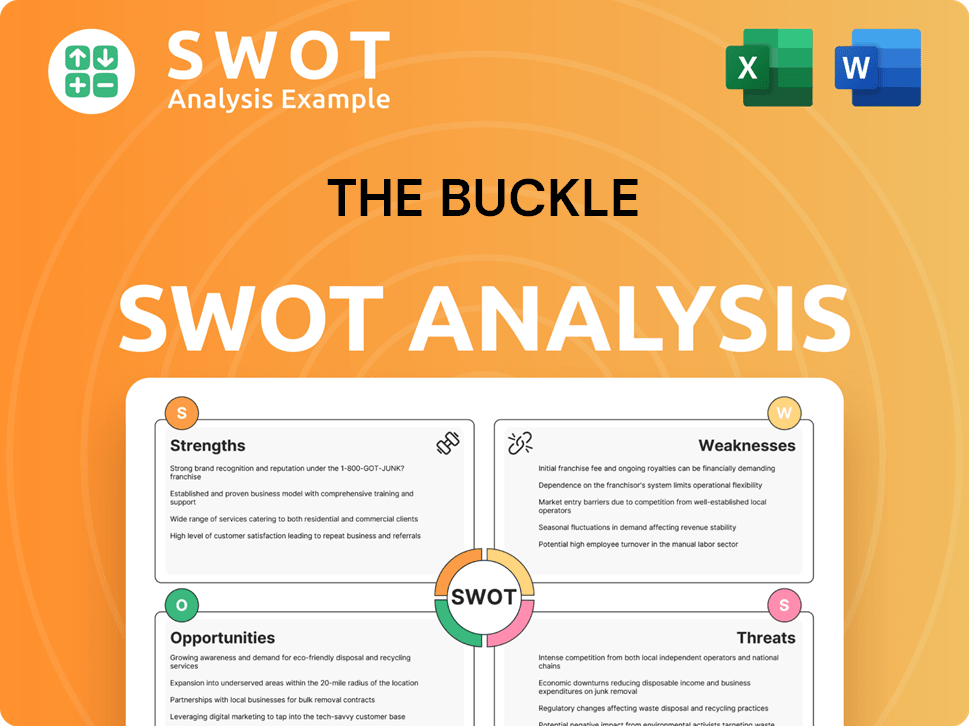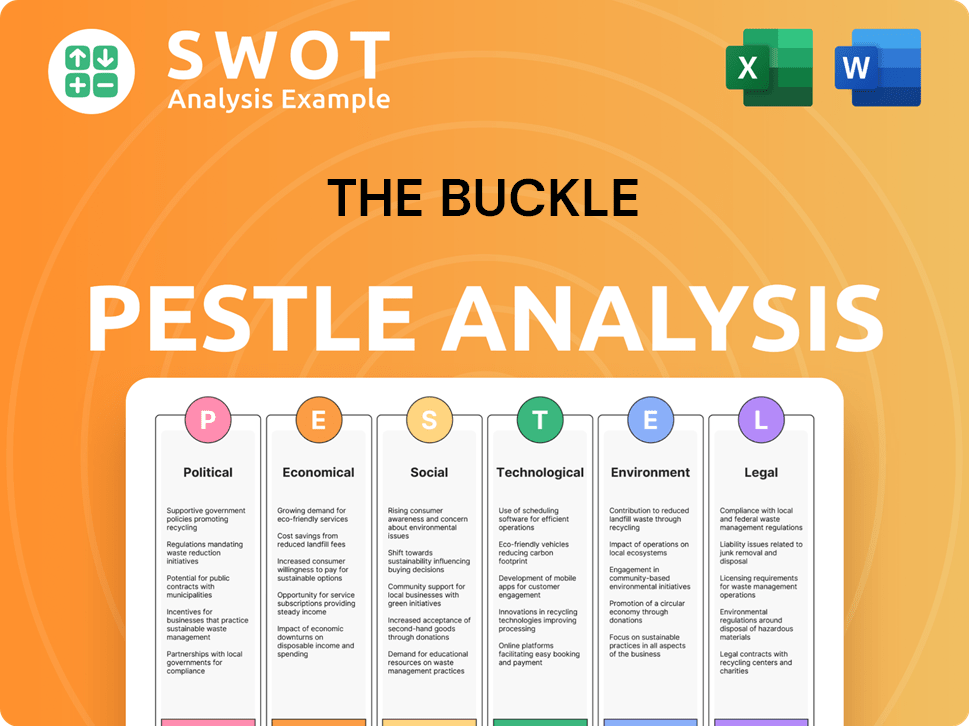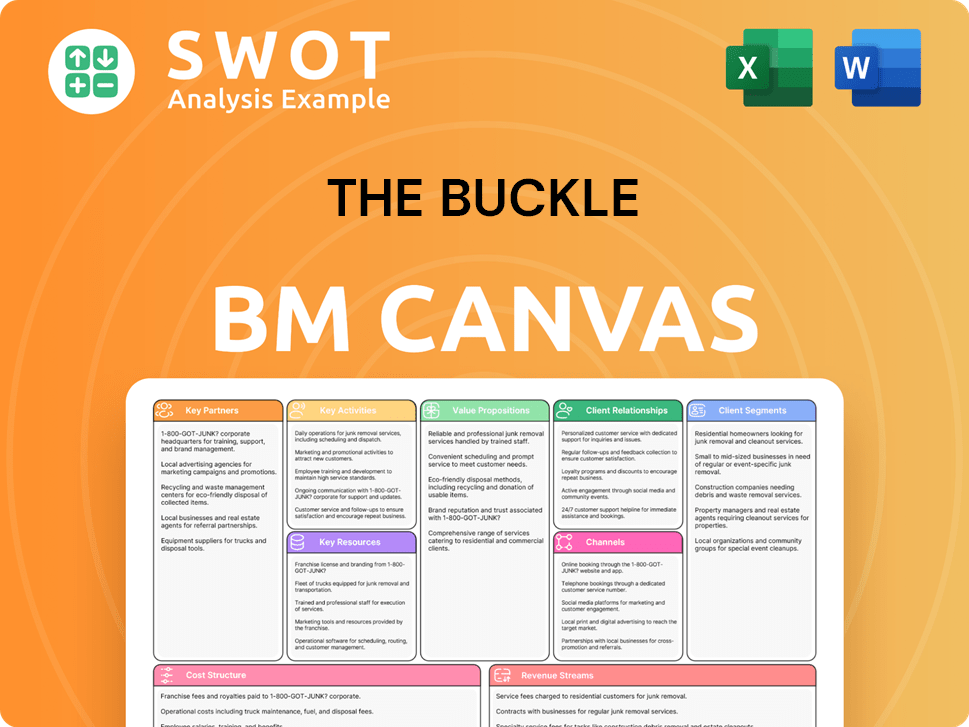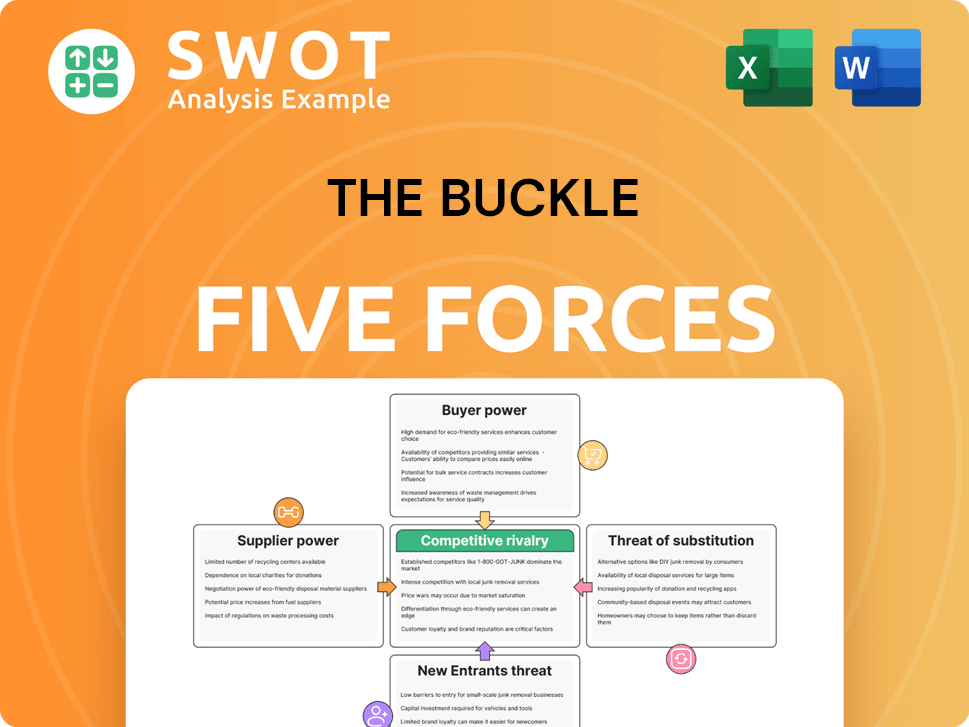The Buckle Bundle
Who Really Calls the Shots at The Buckle Company?
Unraveling the ownership structure of The Buckle, Inc. is key to understanding its strategic moves and long-term vision. Ownership is more than just a financial detail; it's the engine that drives corporate culture and influences decisions, from the latest The Buckle SWOT Analysis to expansion plans. Knowing who owns Buckle clothing stores provides critical insights into its enduring presence in the competitive retail landscape.

From its humble beginnings as Mills Clothing to its current status as a publicly traded entity, the Buckle Company's ownership has evolved significantly. This exploration will examine the shifts in ownership, tracking the influence of founders, early investors, and major shareholders. Understanding the interplay between Buckle ownership and governance is essential for grasping the forces shaping its past, present, and future, including its market position and financial performance.
Who Founded The Buckle?
The roots of The Buckle, Inc. can be traced back to 1948 when David Hirschfeld established Mills Clothing in Kearney, Nebraska. Initially, the business focused on men's workwear. The company later evolved and rebranded to The Buckle in 1967.
During its early years, the ownership of The Buckle, Inc. was primarily held within the Hirschfeld family. The company's initial growth and strategic direction were directly influenced by David Hirschfeld.
Early financial backing for The Buckle would have mainly come from family capital and reinvested earnings, which was typical for businesses of that era. There is no publicly available information on significant outside investors during this initial phase, apart from the core family involvement. The early business agreements likely followed traditional private business structures, with the founder maintaining control.
David Hirschfeld founded Mills Clothing in 1948, which later became The Buckle.
The initial focus was on men's workwear, evolving to fashion retail.
Ownership was primarily concentrated within the Hirschfeld family during the early years.
Early funding came from family capital and reinvested earnings.
The company rebranded to The Buckle in 1967.
The Hirschfeld family held centralized control, guiding the company's direction.
For more details on the company's beginnings, you can read a Brief History of The Buckle. Today, The Buckle operates as a publicly traded company. As of early 2024, the company has reported consistent revenue, with a focus on providing quality apparel. The company has shown a commitment to maintaining a strong financial position. In 2023, The Buckle reported net sales of approximately $1.09 billion. The company has a significant number of Buckle stores across the United States. The current CEO is Dennis Nelson. The company's headquarters are located in Kearney, Nebraska.
The Buckle SWOT Analysis
- Complete SWOT Breakdown
- Fully Customizable
- Editable in Excel & Word
- Professional Formatting
- Investor-Ready Format

How Has The Buckle’s Ownership Changed Over Time?
The ownership structure of The Buckle, Inc. underwent a major shift with its initial public offering (IPO) on November 19, 1992. This transition marked the move from a privately held, family-run business to a publicly traded company. The IPO allowed for a wider range of investors, including both institutional and individual investors, and provided capital for expansion. While the initial market capitalization at the time of the IPO isn't readily available in recent public records, the offering significantly diversified its shareholder base.
Currently, major stakeholders in The Buckle, Inc. include institutional investors, mutual funds, and individual insiders, particularly members of the Hirschfeld family. As of early 2025, institutional ownership remains substantial. For instance, BlackRock, Inc. and The Vanguard Group are consistently among the top institutional holders, reflecting their passive investment strategies across broad market indices. These firms typically hold several million shares each, representing a significant portion of the outstanding common stock. For example, as of the first quarter of 2025, The Vanguard Group held approximately 6.5 million shares, representing around 13.5% of the company's total shares outstanding, and BlackRock, Inc. held roughly 5.8 million shares, equating to about 12.0%.
| Stakeholder | Approximate Shareholding (Early 2025) | Percentage of Shares Outstanding (Approximate) |
|---|---|---|
| The Vanguard Group | ~6.5 million shares | ~13.5% |
| BlackRock, Inc. | ~5.8 million shares | ~12.0% |
| Insider Ownership (Executives & Directors) | Significant (Variable) | Often exceeding 20% |
The Hirschfeld family, descendants of the founder David Hirschfeld, continues to maintain a notable ownership stake and influence. Dennis H. Nelson, the President and CEO, who is also a member of the Hirschfeld family by marriage, holds a significant number of shares. As of early 2025, insider ownership, which includes executives and directors, collectively represents a meaningful percentage, often exceeding 20% of the total shares, demonstrating continued alignment between management and shareholder interests. These ownership changes have profoundly impacted company strategy, shifting towards greater transparency and accountability to a wider range of shareholders, while still retaining a degree of family influence in its core operations and long-term vision.
The Buckle, Inc.'s ownership structure has evolved significantly since its IPO in 1992, transitioning from a family-dominated business to a publicly traded company.
- Institutional investors like BlackRock and The Vanguard Group hold significant shares.
- The Hirschfeld family maintains a notable ownership stake and influence.
- Insider ownership, including executives and directors, often exceeds 20%, aligning management and shareholder interests.
- For more details, you can read this article about The Buckle.
The Buckle PESTLE Analysis
- Covers All 6 PESTLE Categories
- No Research Needed – Save Hours of Work
- Built by Experts, Trusted by Consultants
- Instant Download, Ready to Use
- 100% Editable, Fully Customizable

Who Sits on The Buckle’s Board?
The current Board of Directors of The Buckle, Inc. (also known as Buckle Company or Buckle Inc) includes a blend of individuals. These individuals represent major shareholders, long-standing executives, and independent members. This composition aims to balance insider knowledge with external oversight. As of early 2025, the board typically includes Dennis H. Nelson, the President and CEO, who also represents a significant insider and family interest. Other key board members often have extensive experience in retail, finance, and corporate governance. Understanding the leadership of the Buckle Company is crucial for investors and stakeholders alike.
The Buckle's board structure reflects a commitment to both operational expertise and independent oversight. The presence of long-serving executives and independent directors ensures a balance of perspectives. This structure supports strategic decision-making and corporate governance. Investors interested in Buckle ownership should pay close attention to these dynamics.
| Board Member | Title | Key Affiliations |
|---|---|---|
| Dennis H. Nelson | President & CEO | Significant Insider, Family Interest |
| [Name Redacted] | Director | Retail and Finance Experience |
| [Name Redacted] | Independent Director | Corporate Governance Expert |
The voting structure for The Buckle, Inc. is generally based on a one-share-one-vote principle for its common stock. This is typical for publicly traded companies. There is no public indication of dual-class shares or special voting rights. However, insiders, particularly the Hirschfeld family and long-serving executives, hold substantial influence. This influence affects strategic decisions and board appointments. This structure impacts the overall Buckle ownership and the company's strategic direction.
Insiders, especially the Hirschfeld family, wield significant influence. This influence affects major decisions and board appointments.
- One-share-one-vote principle for common stock.
- No dual-class shares or special voting rights are publicly indicated.
- Major decisions often align with the founding family's long-term vision.
- Understanding the board's composition is crucial for investors.
While The Buckle has not been involved in recent high-profile proxy battles, the concentrated insider ownership means that major decisions often align with the long-term vision of the founding family. The board's composition and voting power dynamics underscore a governance model that combines the interests of public shareholders with the enduring influence of its original stakeholders. To understand the broader context, consider the Competitors Landscape of The Buckle.
The Buckle Business Model Canvas
- Complete 9-Block Business Model Canvas
- Effortlessly Communicate Your Business Strategy
- Investor-Ready BMC Format
- 100% Editable and Customizable
- Clear and Structured Layout

What Recent Changes Have Shaped The Buckle’s Ownership Landscape?
Over the past few years, The Buckle, Inc. (Buckle Company) has demonstrated ownership trends typical of a mature, publicly traded retailer. The company has consistently engaged in share buyback programs. These programs, supported by strong cash flow, aim to return value to shareholders by reducing the number of outstanding shares. In fiscal year 2024, The Buckle continued its share repurchase initiatives, showcasing a commitment to enhancing shareholder value.
Industry trends in ownership for apparel retailers often include increased institutional ownership. The Buckle is no exception, with major institutional investors holding substantial stakes. While founder dilution is a natural consequence of public offerings and the passage of time, the Hirschfeld family and insiders continue to maintain a notable ownership percentage, indicating sustained commitment and influence.
| Metric | Details | Source |
|---|---|---|
| Institutional Ownership | Significant holdings by Vanguard and BlackRock | Public Filings |
| Share Repurchases | Ongoing in fiscal year 2024 | Company Reports |
| Insider Ownership | Notable percentage held by the Hirschfeld family | Public Filings |
The ownership profile of The Buckle suggests a stable, publicly traded entity with a significant insider presence. Future ownership changes are likely to be incremental, driven by ongoing share repurchase programs, changes in institutional holdings, and potential generational shifts in insider ownership. The company's focus remains on balancing market demands with a long-term strategic vision.
The Buckle has consistently utilized share buybacks to return value to shareholders, reducing the number of outstanding shares. These buybacks often lead to an increase in earnings per share and potentially the stock price. This strategy demonstrates a commitment to enhancing shareholder value and managing capital effectively.
Major institutional investors like Vanguard and BlackRock hold substantial stakes in The Buckle. These investments reflect passive investment in the broader market, indicating confidence in the company's performance. Institutional ownership provides stability and supports the company's market position.
The Hirschfeld family and other insiders continue to maintain a notable ownership percentage. This sustained commitment shows a long-term strategic vision and a vested interest in the company's success. Insider ownership helps align the interests of management and shareholders.
Future ownership changes are likely to be incremental, driven by share repurchases and shifts in institutional holdings. The company's stable ownership structure suggests a focus on long-term growth. The Buckle continues to balance market demands with a strategic vision.
The Buckle Porter's Five Forces Analysis
- Covers All 5 Competitive Forces in Detail
- Structured for Consultants, Students, and Founders
- 100% Editable in Microsoft Word & Excel
- Instant Digital Download – Use Immediately
- Compatible with Mac & PC – Fully Unlocked

Related Blogs
- What are Mission Vision & Core Values of The Buckle Company?
- What is Competitive Landscape of The Buckle Company?
- What is Growth Strategy and Future Prospects of The Buckle Company?
- How Does The Buckle Company Work?
- What is Sales and Marketing Strategy of The Buckle Company?
- What is Brief History of The Buckle Company?
- What is Customer Demographics and Target Market of The Buckle Company?
Disclaimer
All information, articles, and product details provided on this website are for general informational and educational purposes only. We do not claim any ownership over, nor do we intend to infringe upon, any trademarks, copyrights, logos, brand names, or other intellectual property mentioned or depicted on this site. Such intellectual property remains the property of its respective owners, and any references here are made solely for identification or informational purposes, without implying any affiliation, endorsement, or partnership.
We make no representations or warranties, express or implied, regarding the accuracy, completeness, or suitability of any content or products presented. Nothing on this website should be construed as legal, tax, investment, financial, medical, or other professional advice. In addition, no part of this site—including articles or product references—constitutes a solicitation, recommendation, endorsement, advertisement, or offer to buy or sell any securities, franchises, or other financial instruments, particularly in jurisdictions where such activity would be unlawful.
All content is of a general nature and may not address the specific circumstances of any individual or entity. It is not a substitute for professional advice or services. Any actions you take based on the information provided here are strictly at your own risk. You accept full responsibility for any decisions or outcomes arising from your use of this website and agree to release us from any liability in connection with your use of, or reliance upon, the content or products found herein.